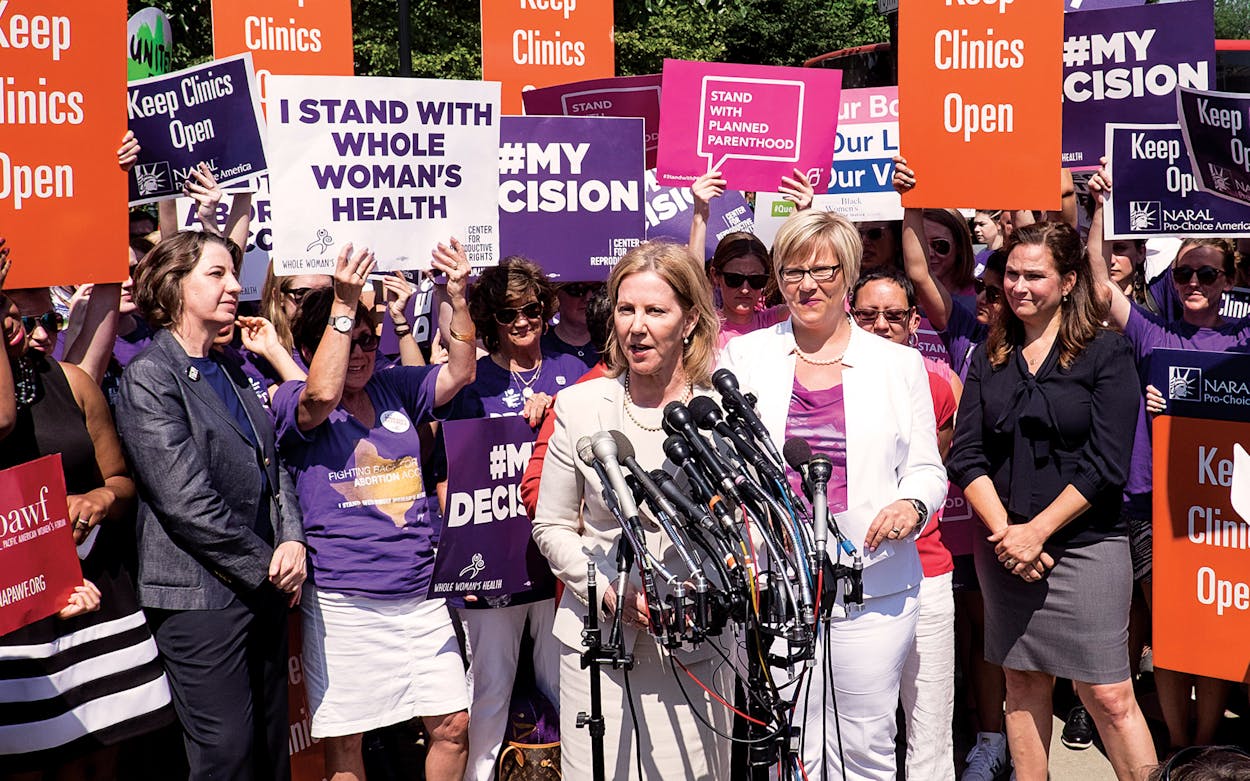In 2013 the battle over abortion in Texas became a major part of the culture. It was the summer of Wendy Davis and her filibuster, and the omnibus abortion bill passed by the Texas legislature in its second special session of the year. By the end of the summer, Davis and the orange-shirted activists who joined her at the Texas Capitol lost, and H.B. 2, which added a slew of restrictions around abortion—banning abortions after twenty weeks of pregnancy; adding requirements that mandated abortions take place in “ambulatory surgical centers” and be performed by doctors with rare hospital admitting privileges; and creating restrictions around medication-based abortions.
Three years later, though, many of those restrictions have been overturned by the U.S. Supreme Court, which found that admitting privileges and ambulatory surgical center requirements created an undue burden that restricted the rights of people seeking abortion care. (The twenty-week ban, which was not challenged as part of the suit, remained in place.) The crucial takeaway from that lawsuit—filed as Whole Woman’s Health v. Helberstedt—was that the Court, which decades earlier had found that it was unconstitutional for states to enact abortion restrictions that created an “undue burden,” finally offered clarity as to what that actually was. And now Whole Woman’s Health, joined by abortion rights organizations like the Afiya Center, Fund Texas Choice, Lilith Fund, Texas Equal Access Fund, West Fund, and San Antonio–based abortion doctor Bhavik Kumar, seeks to overturn a number of laws in Texas that, their lawsuit maintains, create an undue burden on those seeking abortion care.
There are a number of restrictions that the suit challenges—and they don’t all originate with 2013’s H.B. 2. Rather, they challenge laws like the 24-hour sonogram requirement, which went into effect in 2012; the information doctors are required to tell patients as a result of the 2016 “A Woman’s Right to Know” document, which includes assertions about abortion that are not supported by medical science; a parental notification law signed in 1999 by then governor George W. Bush; laws that require abortion providers to report detailed information to the state; laws that mandate follow-ups that may not be medically necessary; and more. (The suit also challenges an interpretation of Texas law by the University of Texas System that means the university doesn’t give students course credit for internships and other placements with groups like the abortion funds that joined Whole Woman’s Health in the suit.)
This is the first major challenge to Texas abortion law since the High Court ruled in Whole Woman’s Health v. Hellerstedt in 2016—which makes it a wild card in terms of the impact it’s likely to have. Prior to that ruling, abortion lawsuits in Texas tended to follow a similar trajectory: to challenge a law, an organization like Whole Woman’s Health or Planned Parenthood would file a suit against the state, which would be heard by a federal judge in a district court in Austin. The first judge hearing the case would often find in favor of the plaintiff, and the suit would escalate to the Fifth Circuit Court of Appeals. That court, most often, would find for Texas. In the case of the challenge to H.B. 2, the plaintiffs then appealed to the U.S. Supreme Court. With no standard for what an undue burden was, the district court judge and the Fifth Circuit could—and often did—disagree about whether the law in question created such a burden.
Now, though, the law is more clear: According to Justice Breyer’s opinion in Whole Woman’s Health v. Hellerstedt, courts don’t just have to consider whether a given regulation restricts access to abortion but also whether that regulation actually benefits anyone. During the SCOTUS hearing, Texas argued that the laws in H.B. 2 made people seeking abortions safer—but the state’s attorneys didn’t have scientific evidence to back that up in any significant way, and the court struck down the law. (Breyer’s opinion also noted that, even if the Legislature does find regulatory benefits, this may not be sufficient to restrict abortion access.)
That means that the pattern established during the 2010s may shake up when it comes to the new lawsuit. Or it may not—the ruling from 2016 does give courts the ability to weigh the benefits and the burdens of a given law on its own, so what the district court—and the Fifth Circuit, in an inevitable appeal—decides will remain to be seen.
- More About:
- Politics & Policy
- Abortion








